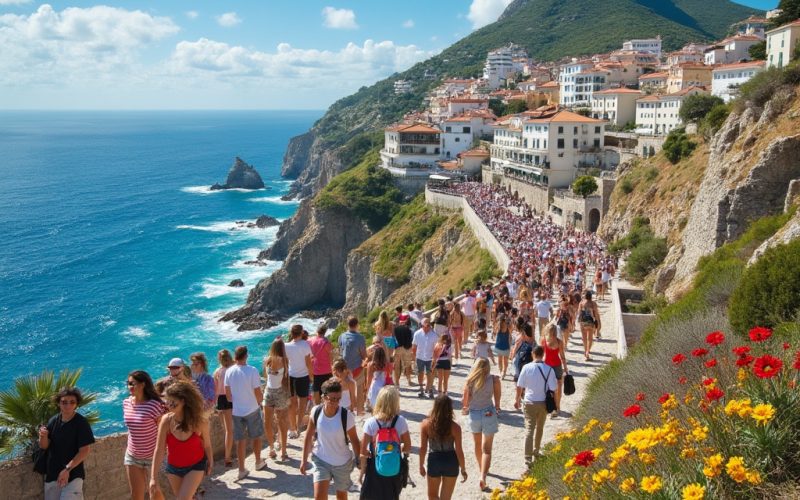
Overtourism – characterized by crowded streets, inflated housing prices, and packed tourist sites is increasingly cited as a growing issue in global tourism. However, according to Randy Durband, CEO of the Global Sustainable Tourism Council, the root of the problem is not the influx of tourists but rather the “lack of management” by local authorities.
To give you an idea:
- Venice, Italy: With a population of about 50,000 residents, Venice receives over 20 million visitors annually, leading to severe overcrowding and strain on local resources.
- Barcelona, Spain: This city hosts 17 million tourists per year, compared to a resident population of about 1.6 million. The massive influx has led to protests from locals who feel the city’s infrastructure is overwhelmed.
- Santorini, Greece: With a population of around 15,000, this island receives close to 2 million visitors annually. The pressure on its small infrastructure has sparked concerns over sustainability.
- Machu Picchu, Peru: UNESCO recommended limiting daily visitors to 2,500 people, yet on some days, the site sees over 5,000 tourists, putting immense pressure on the ancient ruins.
- Thailand’s Maya Bay: The beach, made famous by the movie The Beach, saw over 5,000 visitors per day, which led to its closure in 2018 to allow for environmental recovery.
Addressing overtourism requires a proactive approach in tourism management, not simply limiting visitor numbers as we will show.
The Role of Destination Marketing Organizations
Durband’s key argument is that Destination Marketing Organizations (DMOs) must evolve from solely promoting destinations to also managing them. “Governments traditionally didn’t see themselves as tourism managers,” Durband says. However, as travel grows, especially with the rise of the global middle class, the need for governments to actively manage tourism is becoming essential.
DMOs should shift their focus from marketing to managing tourist flows. This shift has already begun but remains in its early stages. Governments must recognize the crucial role they play in tourism management, whether through infrastructure development or crowd control measures.
Smart Management of Visitor Flows
One promising solution to overtourism is the management of visitor flows rather than restricting overall tourism levels. This approach aims to distribute visitors more evenly across different times and locations, reducing the impact on overcrowded areas. Local governments worldwide are gradually adopting this approach, and examples of success can already be found.
China, for instance, has been particularly successful in managing large tourist populations. At the Leshan Giant Buddha for instance, the municipal government created adjacent attractions to disperse crowds and installed technology to monitor the flow of visitors. Such strategies not only reduce congestion but also enhance visitor experiences.
Similarly, in the small French village of Saint Guilhem le Désert, changes to traffic flow were implemented after an ambulance was delayed due to congestion. Now, visitors are directed to park outside the village and use sustainable transport options, such as bicycles or electric buses, to enter. These measures have improved both safety and visitor experience, while also protecting the town’s heritage.
Technology’s Role in Tourism Management
Implementing technological solutions to monitor and control visitor numbers is another effective way to manage tourism. Tourist destinations like Disney World have long employed these strategies, but local governments are now beginning to adopt similar practices.
For instance, Barcelona, a city visited by 17 million tourists annually, is working to manage tourist flows rather than simply reduce visitor numbers. The city’s officials aim to avoid exceeding social and environmental limits, but the challenge is complex. Visitors in Barcelona often want to visit the same areas that locals frequent, which increases tensions between tourists and residents. Implementing technologies that monitor visitor movement in real-time will be crucial in mitigating this issue.
Managing Capacity in a Growing World
Global travel demand will not decline. With a world population of 8 billion and a growing middle class in regions like Asia-Pacific, tourism will continue to rise. As a result, governments must increase their management capacity and develop strategies to spread visitors more evenly across destinations.
To prevent overtourism, it is not just about limiting numbers but smartly managing where, when, and how tourists move through a destination. By increasing capacity in under-visited areas and using technological solutions, destinations can maintain a balance between tourism growth and local sustainability.
Time for a Paradigm Shift
The solution to overtourism lies in rethinking how destinations manage tourism. By shifting from promotion to management, local governments can take an active role in ensuring that tourism is both sustainable and beneficial to residents and visitors alike. The challenge is significant, but it is absolutely possible to prevent overtourism with the right strategies in place.
